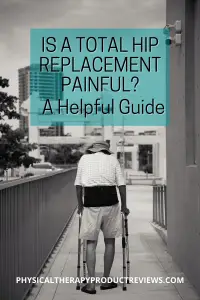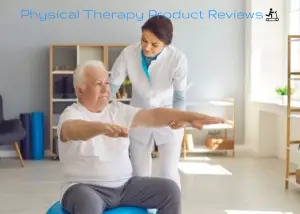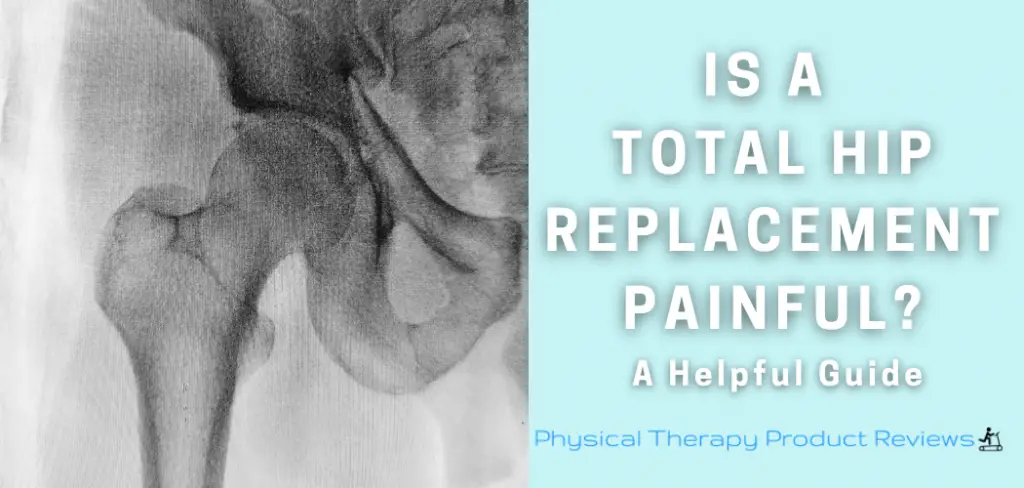 A total hip replacement is one of the most common surgeries in the United States. Millions of people undergo this procedure every year, often with little or no pain afterward.
A total hip replacement is one of the most common surgeries in the United States. Millions of people undergo this procedure every year, often with little or no pain afterward.
However, pain after total hip replacement surgery can be a concern for some patients. Just how painful is a hip replacement? Should you be worried about the pain levels.
For a hip replacement, the pain is typically well controlled and less than the general expectations.
This blog post will review if total hip replacement surgery is painful and discuss ways to reduce pain following total hip replacement surgery.
Is a Total Hip Replacement Painful?
Pain after a total hip replacement is different and subjective for each person. While it may vary from person to person, it is typically rated as moderate and less painful than a total knee replacement for comparison.
A total hip replacement is a surgical procedure to replace the ball and socket of your hip. Most total hip replacements are performed in older adults who have arthritis in their hips. Other conditions that also lead to a total hip replacement surgery include avascular necrosis and trauma, such as a fracture.

A total hip replacement is considered one of the most successful surgeries in modern medicine. Most people with total joint replacements can expect to live normal lives with little or no pain after their procedure, especially after taking care of themselves following total hip replacement surgery.
However, the high success of the surgery doesn’t mean it’s pain-free. As with any surgery, there is an expected post-surgical pain that can last 2-3 weeks. There is also pain associated with healing and weak muscles that can last for another 4-6 weeks after the initial acute pain wears off.
Alternatively, a hip replacement is often just as or even less painful than the severe pain from arthritis before surgery.
All in all, the pain after a hip replacement can be severe for a short period, as is expected after any surgery. However, patients tend to recover more quickly after this surgery than most others.
What's More Painful? A Hip Replacement vs. Knee Replacement
Typically a knee replacement is more painful than a hip replacement. People may have different opinions, but we consistently see less pain after hip replacements in the clinic.
This is true for a couple of reasons. In a total knee, it’s a more unstable joint and relies heavily on muscles and ligaments for stability. It also tends to take more time to regain range of motion and has more stiffness after surgery.
The range of motion after a hip replacement tends to be easier to get back to normal and happens gradually over time. The hip is a much more stable joint and relies more on form-fitting stability as opposed to muscles.
Managing Pain After a Hip or Knee Replacement
Why Is a Hip Replacement Painful?
A total hip replacement is one of the most successful surgeries in modern medicine. It reduces pain and improves mobility. However, not everyone goes through a total joint replacement without high levels of pain. In rare cases, people experience increased pain after a total hip replacement.
People experience pain after total hip replacement because of the surgery itself, swelling, muscle tightness and spasms after surgery.
Post-Surgical Pain After a Hip Replacement
Total hip replacement patients can expect to feel moderate pain levels after the procedure as their body recovers from the surgery.
This post-surgical pain usually lasts around 2-3 weeks. It may last longer for some, depending on their injury and how healthy they were before total hip replacement surgery.
This surgery effects:
- Muscles
- Ligaments
- Bones
All of which are healing after being cut, manipulated, and adjusted with a new prosthesis.
Post-Op Swelling and Pain After a THA
Post-op swelling is often the cause of pain after surgery. Patients can expect increased swelling in their legs, buttocks, and hips for the first few days after total hip replacement surgery. This resolves slowly over the first 6 weeks.
The swelling is most prominent immediately after surgery. The more swelling within the joint, the more pressure and the higher the pain.
Pro Tip: One of the best ways to decrease swelling after a hip replacement is movement. Walking and moving the leg pumps swelling out of the joint.
Muscle Tightness and Guarding After Hip Surgery
Another cause of post-op pain is muscle tightness and guarding.
After surgery, the body knows that the joint and muscles surrounding the joint just suffered serious trauma. The body instinctively tightens the muscles. This can become so severe that it causes painful spasms. Long-standing muscle tightness after surgery causes achiness and pain that is uncomfortable to deal with.
Tips to Reduce Pain After a Hip Replacement Surgery
The best way to prevent pain after total hip replacement is to prepare for it. Patients can do their part by taking the necessary steps before surgery and during recovery to limit total hip replacement pain as much as possible:
Get Moving After a Hip Replacement As Soon As You Can
One of the best ways to decrease total hip replacement pain is through movement and exercise.
It’s important to walk as soon after surgery as possible and continue moving during recovery. You’ll notice that the joint feels less stiff after walking and doing your range of motion exercises.
Less stiffness in the joint often leads to a decrease in pain. The more time you spend sitting and being sedentary, the higher the pain levels get and the more stiffness in the joint.
It will take some time before you can move completely normally, but staying active rather than sitting around all day is essential. You may think that you should rest and allow things to heal before moving. However, this is not the case. Sitting slows down your recovery.
Related Topic: The Best Exercise Bike After a Total Hip Replacement
Go to Physical Therapy After Hip Surgery
Physical therapy is a massive part of the recovery after a total hip replacement. Patients need to attend physical therapy after surgery to safely move their new hip and strengthen the muscles around it. It will help improve your walking mechanics, decrease your pain levels, and educate you on safe ways to strengthen the hip.

If someone does not go to PT, this may cause muscle weakness down the road. This can lead to issues later and even cause pain in other joints that compensate for the lack of strength.
Take Pain Medication As Prescribed After a Hip Replacement Surgery
It’s extremely important to follow the doctor’s post-op instructions for taking medication after total hip replacement surgery. Depending on their pre-surgery health and medical history, patients may be prescribed opioids for total hip replacement pain relief or nonsteroidal anti-inflammatory drugs (NSAIDs) like ibuprofen or naproxen.
Try and stay ahead of the pain and take the medication as prescribed for the first few days. Once the pain is under control, then you can start to reduce the medication progressively.
Avoid Smoking and Follow a Healthy Diet
Avoid smoking and follow a healthy diet before and after a total hip replacement. Smoking increases the risk of complications, lengthens total hip replacement recovery time, and causes poor blood flow to the newly reconstructed joint replacement.
Eating healthy helps maintain lower body weight and takes pressure on the joint. It also provides the body with the needed nutrients it needs to recover after surgery.
Use Pain Relieving Aids
Finally, using pain-relieving aids can help control and maintain lower pain levels after surgery. Use ice packs, over-the-counter pain medications, and prescription medication as ordered by your doctor to manage total hip replacement pain after surgery.
We recommend using a circulating ice machine that keeps the water cold, and you can set a timer for how long you want it to run. This is perfect for use at night to fall asleep with it on but won’t risk causing injury because it shuts off.
Conclusion
A total hip replacement is a surgical procedure that can be painful to recover from. Patients can do their part by taking the necessary steps before surgery and during recovery to limit total hip replacement pain as much as possible including, moving and walking as much as you can, using ice and other pain relievers, and preventing sitting in one position for too long. The pain typically starts to improve within 2-3 weeks after surgery, and you can begin to progress your recovery from there.
Other Great Physical Therapy Related Articles
How to Stay Active After Cervical Fractures: Expert Tips and Advice
Dealing with Painful Stairs After Ankle Replacement Surgery
Walking After a Total Ankle Replacement: Tips for a Successful Recovery
Exercises While Non-Weight Bearing After Ankle Replacement: Elevation, AROM, Leg Raises, and More
Ankle Pain with Stairs: Causes and Home Treatment Options
5 Common Mistakes You’re Making After an Ankle Sprain
Disclaimer: The information provided in this post is for educational purposes only. This is not a substitute for a medical appointment. Please refer to your physician before starting any exercise program.








